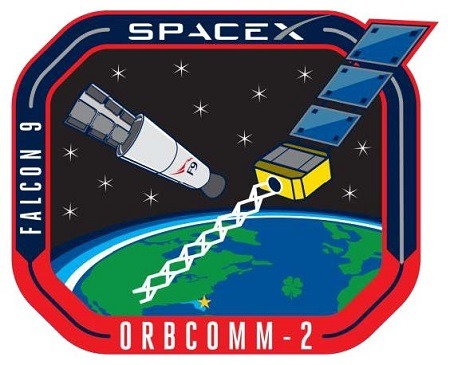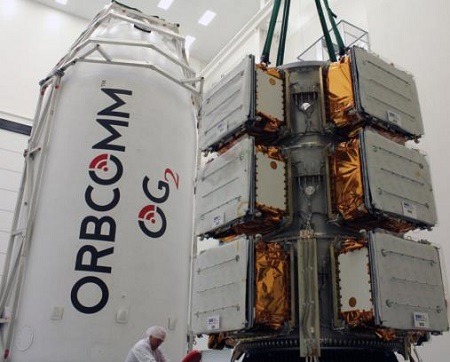Mission Overview
With this mission, SpaceX’s Falcon 9 rocket will deliver 11 satellites to low-Earth orbit for ORBCOMM, a leading global provider of Machine-to-Machine (M2M) communication and Internet of Things (IoT) solutions.

The ORBCOMM launch is targeted for an evening launch from Space Launch Complex 40 at Cape Canaveral Air Force Station, Fla. If all goes as planned, the 11 satellites will be deployed approximately 20 minutes after liftoff, completing a 17-satellite, low Earth orbit constellation for ORBCOMM.
This mission also marks SpaceX’s return-to-flight as well as its first attempt to land a first stage on land. The landing of the first stage is a secondary test objective.
Payload
ORBCOMM OG2 is the world’s first and only commercial satellite network 100 percent dedicated to machine-to-machine (M2M) communications. The ORBCOMM network uses low-Earth orbit satellites to provide reliable and cost-effective M2M communications to and from the most remote areas of the world.
ORBCOMM satellites are constantly in motion around the Earth, providing inherent network redundancy and minimizing line-of-sight issues for continuous global coverage. Each satellite’s VHF frequency furthers signal propagation and message delivery is unaffected by bad weather. In addition, the optimized message size is ideal for M2M applications.

Each OG2 satellite will offer up to twelve times the data access and up to twice the transmission rate of an existing OG1 satellite. Each OG2 satellite is the equivalent of six OG1 satellites, providing faster message delivery, larger message sizes and better coverage at higher latitudes, while significantly increasing network capacity.
ORBCOMM’s proven ground infrastructure enables worldwide M2M satellite messaging. The company’s 16 Gateway Earth Stations in 13 countries track and establish two-way satellite communications, while the company’s Gateway Control Centers process the data and provide the interconnection to terrestrial communications networks. ORBCOMM’s Network Control Center in Sterling, Va. serves as the focal point for managing the company’s satellite constellation and ensuring reliable message delivery.
Mission Timeline
COUNTDOWN
Hour/Min Events
– 00:34 Launch Conductor takes launch readiness poll
– 00:30 RP-1 (rocket grade kerosene) and liquid oxygen (LOX) loading underway
– 00:10 Falcon 9 begins engine chill prior to launch
– 00:02 Range Control Officer (USAF) verifies range is go for launch
– 00:01:30 SpaceX Launch Director verifies go for launch
– 00:01 Command flight computer to begin final prelaunch checks
– 00:01 Pressurize propellant tanks
– 00:00:03 Engine controller commands engine ignition sequence to start
00:00:00 Falcon 9 liftoff
LAUNCH AND FIRST-STAGE LANDING
Hour/Min Events
00:01 Max Q (moment of peak mechanical stress on the rocket)
00:02:20 1st stage engine shutdown/main engine cutoff (MECO)
00:02:24 1st and 2nd stages separate
00:02:35 2nd stage engine starts
00:03 Fairing deployment
00:04 1st stage boostback burn
00:08 1st stage re-entry burn
00:10 2nd stage engine cutoff (SECO)
00:10 1st stage landing
00:15 ORBCOMM satellites begin deployment
00:20 ORBCOMM satellites end deployment
00:26 1st satellite completes antenna & solar array deployment & starts transmitting
00:31 All satellites complete antenna & solar array deployment & start transmitting
Launch Facility
SpaceX’s Space Launch Complex 40 at Cape Canaveral Air Force Station is a world-class launch site that builds on strong heritage: The site at the north end of the Cape was used for many years to launch Titan rockets, among the most powerful rockets in the U.S. fleet. SpaceX took over the facility in May 2008. The center of the complex is composed of the concrete launch pad and flame exhaust duct. Surrounding the pad are four lightning towers, fuel storage tanks, and the integration hangar. Before launch, Falcon 9’s stages and the payload are housed inside the hangar. The 11 OG2 satellites were encapsulated at the hangar. Following encapsulation, the launch vehicle mated to the transporter erector and rolled from hangar to launch pad on fixed rails prior before launch.
WEBCAST | Launch webcast will be live at spacex.com/webcast approximately 20 min before launch.


Trackbacks/Pingbacks